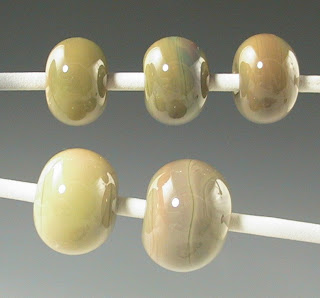 Lauscha is famous for it's pinks - lovely pinks, reds and purples. This particular pink is called Fuchsia - although I would say it's a little pale for fuchsia, myself.
Lauscha is famous for it's pinks - lovely pinks, reds and purples. This particular pink is called Fuchsia - although I would say it's a little pale for fuchsia, myself.The instructions say it will go darker the more you work it. I actually haven't found that. It gets more intense as it gets thicker, of course, but I don't find it getting that much darker.
 It shows a light goldy shadow in the glass - especially in these small spacers, that I'm not sure if I like or not. I could probably convince myself that I liked it. I wouldn't miss it if it wasn't there!
It shows a light goldy shadow in the glass - especially in these small spacers, that I'm not sure if I like or not. I could probably convince myself that I liked it. I wouldn't miss it if it wasn't there! In fact, it has gone away in this large (1.25 inch) pink ring. Why did I make a large, single colour, transparent pink ring? I don't know either.
In fact, it has gone away in this large (1.25 inch) pink ring. Why did I make a large, single colour, transparent pink ring? I don't know either.Interestingly - this colour is also much more vibrant under the lights of my photography set up - see 1st picture of ring.
And paler in the light of a regular bulb, over by the monitor - see second pic, desaturated to show it's true color in most light.

Interestingly - I ran out of the rod before this was quite finished, and I filled in with a little amethyst and some clear. It's not obvious to casual, or even informed inspection. But when I was cleaning it, and it was underwater - it was very obvious.
Pretty shade of pink, pale rose colour or fuchsia - depending on the lighting. I wonder what other interesting tricks it has up it's sleeve?









